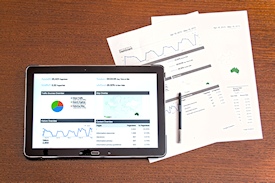When checking website statistics in Google Analytics one area you should pay close attention to is bounce rates. The bounce rate is the percentage of visitors to a website who navigate away from the site after viewing only one page.
 If you have a very high percentage it can be a sign of problems with your content. If you only have a one page website it is not a problem as there are no other pages for the visitor to navigate to. If you have lots of pages with different content but still have a high bounce rate then it may be a cause for concern. It can mean that people are not engaged with your content, or worse still are being put off by what they find on your website.
If you have a very high percentage it can be a sign of problems with your content. If you only have a one page website it is not a problem as there are no other pages for the visitor to navigate to. If you have lots of pages with different content but still have a high bounce rate then it may be a cause for concern. It can mean that people are not engaged with your content, or worse still are being put off by what they find on your website.
Bounce rates shouldn’t be looked at in isolation, even with a high percentage it can mean that your content reflects exactly the information your visitor was looking for and they simply have no need to navigate any further. It is useful to analyse other metrics such as the time spent on a page in conjunction with bounce rate statistics.
Bounce rates can be incredibly useful for giving you an indication of whether your marketing efforts are working, and if your content is of sufficient quality and relevancy. Very often you will discover that there are widely different bounce rates for different sources. For example your social media bounce rate could be 40%, but your pay per click bounce rate is at 85%. This would be a very good pointer that your content is of some value, but could indicate your pay per click campaign is not correctly targeted, or inappropriate for the visitors that are arriving via this medium.
Bounce rates can be misleading if you do not drill down through the data. When examining referral traffic the statistics given before applying any filters will often include something called referrer spam on a lot of websites. Referrer spam is often targeted to generate referrals back to the spam sites. You can block it using a .htaccess file on your server. This will stop them from corrupting your statistics and placing load on your server, although there are new sources of referrer spam appearing all the time. You can also use filters within Google Analytics to prevent the referrer spam from affecting your report.
Even if you leave the referrer spam statistics in place you can use the reports to get very useful information to assist you in assessing your content and if it needs improvement. Bounce rates for landing pages, which are the pages that are the entry point for your website, can provide some very useful insights into what your visitors are doing and are engaged with. Comparing your pages that have lower bounce rates against those that have higher rates can give you indicators as to what your visitors are looking for, and can give your an insight in to which content may benefit from improvement.
 Don’t get obsessed about bounce rates, remember it is conversions that are important and only if your bounce rates are pointing to ways your can increase conversions should you try and address any issues. If you have a 100% bounce rate on your contact page if could be that everyone that goes to that page gets in touch with you, so 100% bounce rate does not necessarily indicate an issue with that page.
Don’t get obsessed about bounce rates, remember it is conversions that are important and only if your bounce rates are pointing to ways your can increase conversions should you try and address any issues. If you have a 100% bounce rate on your contact page if could be that everyone that goes to that page gets in touch with you, so 100% bounce rate does not necessarily indicate an issue with that page.
Improving your Bounce Rate
Once you have an understanding of what your bounce rates mean you can take action to improve the statistics, if it would be of benefit to increase conversions on your website.
- Improve your content.
- Review and amend your advertising campaigns. Are you targeting relevant keywords that match your content?
- Create content, e.g. landing pages that satisfy your visitors requirements.
- Improve navigation – if could be that visitors are struggling to find their way around your website.
- Improve layout and appearance, images and infographics can help engage visitors with your content.
- Clear calls to action that are relevant to the landing pages.
- Create more content related to your existing content that has low bounce rates.
- Check the technical setup of your website, it could be that your pages are taking too long to load, and your visitors are not waiting around. Is your website responsive, so that it will display correctly across different browsers and devices?
- Add more links within your content to other related content on your website.
If you would like any assistance with setting up statistics for your website or analysis of your website bounce rate and how you can improve it get in touch.
Meemo Digital Ltd is a website and digital consultancy company, with a focus on getting to know our customers, and helping you unlock your potential.
Request a free analysis
Meemo Digital offer professional website and digital consultancy services, working together with you to develop a tailor made digital strategy for your business.
Subscribe to our newsletter!
About this blog
Meemo Digital Ltd is a website and digital consultancy company, with a focus on getting to know our customers, and helping you unlock your potential.








